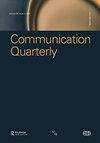Freedom-prompting reactance mitigation strategies function differently across levels of trait reactance
IF 1
Q2 COMMUNICATION
引用次数: 7
Abstract
ABSTRACT This study assessed the relative effects of reactance mitigation strategies specifically designed to prevent or restore threatened autonomy according to message recipients’ levels of reactance proneness. An experiment (N = 230) using a 2 (inoculation mitigation: present vs. absent) × 2 (freedom threatening language: high vs. low) × 2 (restoration postscript mitigation: present vs. absent) between-subjects design was performed in the context of a safe-sex campaign message. Results showed that message strategies affected state reactance differently across levels of trait reactance. In particular, for those high in trait reactance, inoculation uniquely reduced perceived threat to freedom, which indirectly increased safe-sex intention via state reactance and attitude toward the health behavior. These results demonstrate the importance of using trait reactance as an audience segmentation variable.自由提示电抗缓解策略在不同的特质电抗水平上起着不同的作用
摘要本研究根据信息接收者的电抗倾向水平,评估了专门为防止或恢复受威胁的自主性而设计的电抗缓解策略的相对效果。在安全性行为宣传信息的背景下,进行了一项实验(N=230),使用受试者之间的2(接种缓解:存在与不存在)×2(威胁自由的语言:高与低)×2。结果表明,不同特质电抗水平的信息策略对状态电抗的影响不同。特别是,对于那些特质抵抗力高的人来说,接种疫苗独特地减少了对自由的感知威胁,这通过状态抵抗和对健康行为的态度间接增加了安全性行为的意愿。这些结果证明了使用特质电抗作为受众细分变量的重要性。
本文章由计算机程序翻译,如有差异,请以英文原文为准。
求助全文
约1分钟内获得全文
求助全文

 求助内容:
求助内容: 应助结果提醒方式:
应助结果提醒方式:


